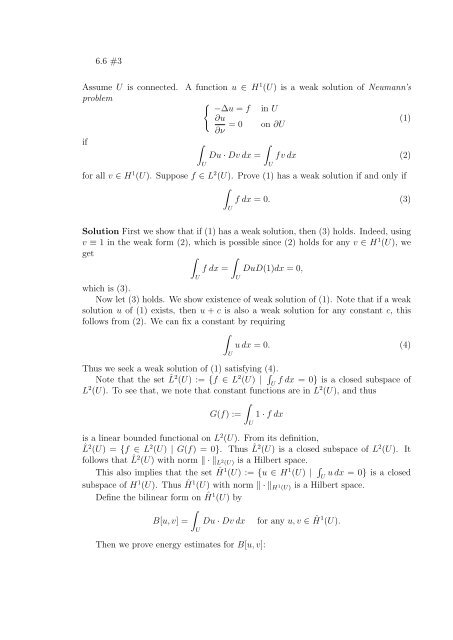You also want an ePaper? Increase the reach of your titles
YUMPU automatically turns print PDFs into web optimized ePapers that Google loves.
6.6 #3<br />
Assume U <strong>is</strong> connected. A function u ∈ H1 (U) <strong>is</strong> a <strong>weak</strong> <strong>solution</strong> <strong>of</strong> Neumann’s<br />
<strong>problem</strong><br />
�<br />
−∆u = f in U<br />
∂u<br />
= 0<br />
∂ν<br />
on ∂U<br />
(1)<br />
if �<br />
�<br />
Du · Dv dx = fv dx (2)<br />
U<br />
U<br />
for all v ∈ H1 (U). Suppose f ∈ L2 (U). Prove (1) has a <strong>weak</strong> <strong>solution</strong> if and only if<br />
�<br />
U<br />
f dx = 0. (3)<br />
Solution First we show that if (1) has a <strong>weak</strong> <strong>solution</strong>, then (3) holds. Indeed, using<br />
v ≡ 1 in the <strong>weak</strong> form (2), which <strong>is</strong> possible since (2) holds for any v ∈ H1 (U), we<br />
get � �<br />
f dx = DuD(1)dx = 0,<br />
U<br />
U<br />
which <strong>is</strong> (3).<br />
Now let (3) holds. We show ex<strong>is</strong>tence <strong>of</strong> <strong>weak</strong> <strong>solution</strong> <strong>of</strong> (1). Note that if a <strong>weak</strong><br />
<strong>solution</strong> u <strong>of</strong> (1) ex<strong>is</strong>ts, then u + c <strong>is</strong> also a <strong>weak</strong> <strong>solution</strong> for any constant c, th<strong>is</strong><br />
follows from (2). We can fix a constant by requiring<br />
�<br />
u dx = 0. (4)<br />
U<br />
Thus we seek a <strong>weak</strong> <strong>solution</strong> <strong>of</strong> (1) sat<strong>is</strong>fying (4).<br />
Note that the set ˆ L2 (U) := {f ∈ L2 (U) | �<br />
f dx = 0} <strong>is</strong> a closed subspace <strong>of</strong><br />
U<br />
L2 (U). To see that, we note that constant functions are in L2 (U), and thus<br />
�<br />
G(f) :=<br />
U<br />
1 · f dx<br />
<strong>is</strong> a linear bounded functional on L 2 (U). From its definition,<br />
ˆL 2 (U) = {f ∈ L 2 (U) | G(f) = 0}. Thus ˆ L 2 (U) <strong>is</strong> a closed subspace <strong>of</strong> L 2 (U). It<br />
follows that ˆ L2 (U) with norm � · �L2 (U) <strong>is</strong> a Hilbert space.<br />
Th<strong>is</strong> also implies that the set ˆ H1 (U) := {u ∈ H1 (U) | �<br />
u dx = 0} <strong>is</strong> a closed<br />
U<br />
subspace <strong>of</strong> H1 (U). Thus ˆ H1 (U) with norm � · �H1 (U) <strong>is</strong> a Hilbert space.<br />
Define the bilinear form on ˆ H1 (U) by<br />
�<br />
B[u, v] = Du · Dv dx for any u, v ∈ ˆ H 1 (U).<br />
Then we prove energy estimates for B[u, v]:<br />
U
By Holder inequality for any u, v ∈ ˆ H 1 (U)<br />
|B[u, v]| ≤ �Du� L 2 (U)�Dv� L 2 (U) ≤ �u� ˆ H 1 (U) �v� ˆ H 1 (U) . (5)<br />
From definition <strong>of</strong> B[u, v], for any u ∈ ˆ H 1 (U)<br />
�Du� 2<br />
L2 (U) = B[u, u]. (6)<br />
Also, since (4) holds, then denoting (u)U := 1<br />
�<br />
|U| U u(x) dx, we get (u)U<br />
using Poincare inequality, we estimate<br />
= 0. Thus,<br />
�u� 2<br />
L2 (U) =<br />
�<br />
u 2 �<br />
dx = (u − (u)U) 2 �<br />
dx ≤ C |Du| 2 dx = CB[u, u],<br />
U<br />
where C depends only on U. Combining th<strong>is</strong> and (6), get<br />
1<br />
C + 1 �u�2 Hˆ 1 = (U) 1<br />
�<br />
C + 1<br />
Also, if f ∈ ˆ L2 , then the functional<br />
�<br />
F (v) =<br />
U<br />
U<br />
u<br />
U<br />
2 + |Du| 2 dx ≤ B[u, u]. (7)<br />
U<br />
fv dx<br />
<strong>is</strong> linear bounded on ˆ H 1 (U). Thus (5) and (7) allow to apply Lax-Milgram theorem<br />
to obtain a unique u ∈ ˆ H 1 (U) such that<br />
B[u, v] = F (v) for all v ∈ ˆ H 1 (U).<br />
Th<strong>is</strong> implies that (2) holds for all v ∈ H1 (U) sat<strong>is</strong>fying �<br />
v dx = 0.<br />
U<br />
Recall that u sat<strong>is</strong>fies (4) and f sat<strong>is</strong>fies (3). Thus if (2) holds for some v ∈ H1 (U),<br />
then (2) also holds for v replaced by v + c, where c<br />
�<br />
<strong>is</strong> any constant. Then (2) holds<br />
for all v ∈ H 1 (U): indeed, if v ∈ H 1 (U) and c = 1<br />
|U|<br />
then we know that (2) holds for v − c, thus for v.<br />
Thus u <strong>is</strong> a <strong>weak</strong> <strong>solution</strong> <strong>of</strong> (1).<br />
U v dx, then v − c ∈ ˆ H 1 (U), and
















